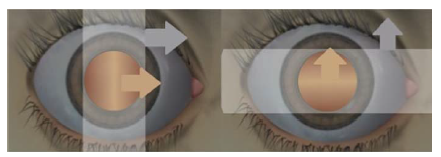Artificial vision through the correlation coefficient for retinoscopy examinations
Main Article Content
Abstract
An automated system was designed and implemented to perform retinoscopy examinations using artificial vision with the correlation coefficient for the processing of retinal images. The technique of observation and experimentation was used to identify the necessary conditions involved in performing the retinoscopy examination. A mechanical, electronic, and artificial vision system design was established to select and install the necessary components for automation. For the operation of the automated system, an algorithm for processing and comparison of images programmed in the LabVIEW software was developed; through a connection to the serial port, data is sent from the computer to the Arduino Uno development board, which controls actuators that are servomotors that direct the position of the lenses and effect the movement of the light beam of the retinoscope. For the automatic change of lenses, a suitable mechanical system was implemented to obtain a fixed retina image; a human-machine interface (HMI) was created, allowing the operator to view the examination process in real-time. With the implementation of the system, the average time of the image comparison was determined, with the result that eyes without ametropia were compared in 162,28 ms, myopia in 166,02 ms, with farsightedness in 170,7 ms and with astigmatism in 174,75 ms, reducing the time taken to perform the retinoscopy examination of 250 to 150 seconds equivalent to 40%. It was concluded that the time of comparison of the images increased by 2.44% while the sea was the refractive damage.
Downloads
Article Details

This work is licensed under a Creative Commons Attribution 4.0 International License.
Authors who publish in this journal agree to the following terms: Authors retain the copyright and guarantee the journal the right to be the first publication of the work, as well as, licensed under a Creative Commons Attribution License that allows others share the work with an acknowledgment of the authorship of the work and the initial publication in this journal. Authors may separately establish additional agreements for the non-exclusive distribution of the version of the work published in the journal (for example, placing it in an institutional repository or publishing it in a book), with acknowledgment of its initial publication in this journal. Authors are allowed and encouraged to disseminate their work electronically (for example, in institutional repositories or on their own website) before and during the submission process, as it may lead to productive exchanges as well as further citation earliest and oldest of published works.
How to Cite
References
[2] “https://www.consejodiscapacidades.gob.ec/wp-content/uploads/downloads/2015/04/registro_nacional_discapacidades - Buscar con Google”.
[3] Juárez Elera y L. G. Rodríguez Gonzales, “Implementación de un Algoritmo para la Detección de Cuerpos Extraños de las Leguminosas de Grano Seco Utilizando la Visión Artificial.”, Universida Nac. Pedro Ruiz Gallo, jun. 2017.
[4] W. D. Furlan, J. G. Monreal, y L. M. Escrivá, Fundamentos de optometría, 2a ed.: Refracción ocular. Universitat de València, 2011.
[5] R. Martín Herranz (). Retinoscopía [Online]. Disponible: http://www.sld.cu/galerias/pdf/sitios/optometria/retinoscopia.pdf
[6] “¿Qué es la hipermetropía?”, CooperVision Spain, 21-nov-2014. [En línea]. Disponible en: https://coopervision.es/cuidado-de-la-vision-y-salud-ocular/que-es-la-hipermetropia. [Accedido: 27-oct-2018].
[7] “¿Qué causa el astigmatismo?”, American Academy of Ophthalmology, 09-ene-2013. [En línea]. Disponible en: https://www.aao.org/salud-ocular/enfermedades/astigmatismo-causas. [Accedido: 27-feb-2018].
[8] Sandoval Niño, Z. L., Prieto Ortiz, F. A. (2007). “Caracterización de café cereza empleando técnicas de visión artificia”l. Revista Facultad Nacional de Agronomía, Medellín, 60(2), 4105-4127.
[9] Ó. F. Motato Toro y H. Loaiza Correa, “Identificación biométrica utilizando imágenes infrarrojas de la red vascular de la cara dorsal de la mano”, Ing. E Investig., vol. 29, n.o 1, 2009.
[10] “Tick Count (ms) Function - LabVIEW 2017 Help - National Instruments”. [En línea]. Disponible en: http://zone.ni.com/reference/en-XX/help/371361P-01/glang/tick_count_ms/. [Accedido: 28-oct-2018].
[11] J. A. Fernández Soler, R. del C. García Pérez, O. M. Mariño Hidalgo, y J. A. Cobas González, “Caracterización de las ametropías atendidas en Consulta de Cirugía Refractiva del Centro Oftalmológico de Holguín”, Correo Científico Méd., vol. 19, n.o 2, pp. 233-245, jun. 2015.
[12] Radio Regulations, Satellite antenna radiation pattern for use as a design objective in the fixed-satellite service employing geostationary satellite, Recommendation ITU-R S.672-4, 1997.

